Nalls’ major social olfactory sculpture, World Sensorium, is the result of over a decade of research into neuroaesthetics, botany, the anthropology of olfaction (or smell), and the “aesthetics of mass anatomy.” This statistically based composition of phyotogenic materials is an on-going work of vast scale and extreme complexity, created to evoke a global memory. Its formula, based on population percentages, reflects her investigation and defining of the “aesthetics of mass anatomy.”
Nalls broadened the definition of sculpture and public art when
World Sensorium premiered at New York’s
Times Square 2000 celebration, released from above onto the crowd of two
million participants as the New Year arrived. The influential work
creatively taps world memory as a natural resource to provide a universal
experience.
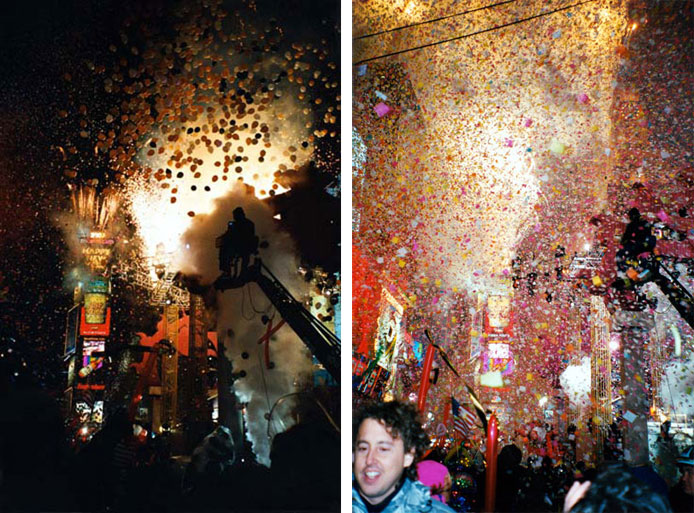
Stagings of the social olfactory sculpture World
Sensorium (1990-2000) took place simultaneously at Times Square, NYC
and at the New Year’s Gala organized by the White House Millennial
Council, Washington, D.C., on New Year’s Eve, 1999-2000; and during
the Jubilee Celebration at the Vatican, 2000. World
Sensorium has been endorsed by UNESCO and The President’s
Committee for the Arts and Humanities. World
Sensorium is ultimately a formless sculpture shaped by the people
embodying it. As an on-going work, the social sculpture grows as it
continues to be shared in international public events involving large
crowds.
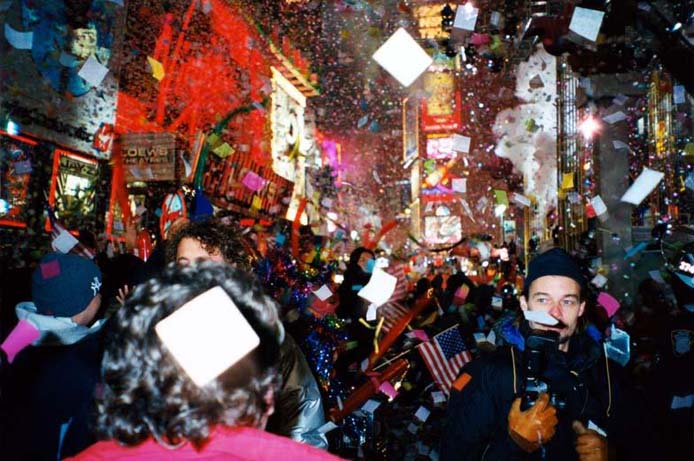
World Sensorium at Times Square 2000

As the New Year arrived, the World
Sensorium paperworks — visual vehicles containing 10 grams of
the olfactory social sculpture — cascaded down with the confetti to
the resonance of two million people, evolving a metabolic collective.
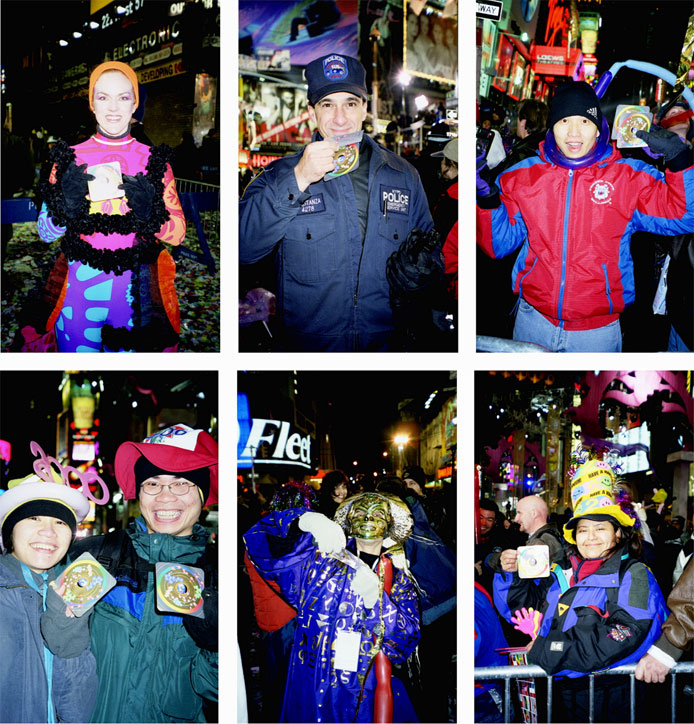
The World Olfactory Social Sculpture provides a visceral experience
For the creation of World Sensorium,
Gayil Nalls conducted a decade-long ethnobotanical research study,
gathering plant, cultural, and olfactory data from living people in 230
countries and territories. Her survey and data-aesthetic methodology
concentrated on identifying plants with which humans historically
interacted through the sense of smell. The aromatic essences of these
plants also perform as memory triggers for the majority of people of a
surveyed country. The phytogenic (plant-based) materials were blended
proportionally according to a mathematical formula based on the
percentage of each nation’s population in the world, producing a
synthesized sensory memory trigger in a single scent. The research
gathered is rich in historical and cultural descriptions of the
geographical experience of aromas and the traditional knowledge of flora.
a new edition is being developed based on projected population statistics
for 2010 formula.
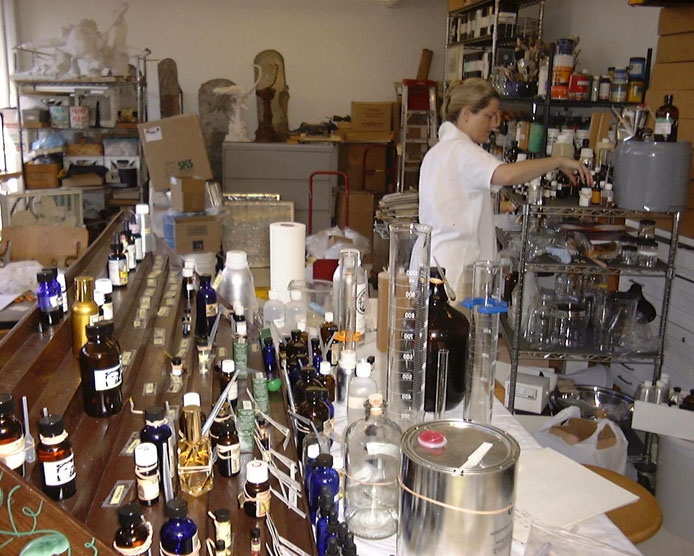
Nalls in her New York studio, preparing to blend World Sensorium.
(Gayil Nalls © 1999-2007)
The research conducted by Nalls for World
Sensorium demonstrated that the human brain co-evolved with plants
over millennia through the exchange of chemical information. In other
words, the brain and the natural environment are one ecosystem. Plants
transmit molecular information, which is apprehended by the human sense of
olfaction. Often the scents having the most therapeutic properties are
those that rise to the highest cultural status within a geographic region,
being used in ritual, cuisine, medicine and protection. Over time, these
scents become iconic within their individual cultures. At an historical
moment of increased alienation from the natural environment, World Sensorium resurrects emerges as sculpture through
the sensory textures it creates in the individual experiencing it,
recognized in the form of their emotions and memories.
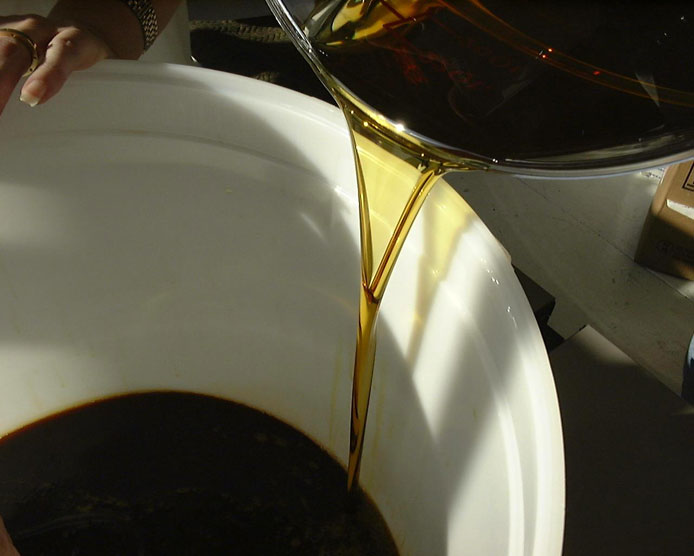
The World Olfactory Social Sculpture is a botanical biosynthesis comprised of plant material most important to humankind's co-evolution with the natural world.
The World Sensorium formula is comprised of 24 percent of various species of Jasmine based on the world population of the countries identifying the variations of this flower as the most powerfully affective cultural and environmental olfactory cue for the people of their country.
The number 1,495,852,024 represents the total population for the year 2000 of China, Pakistan, Algeria, Kenya, Saudi Arabia, Tunisia, Paraguay, Macau, and Djibouti, the countries represented by several species of Jasmine as their most culturally significant scent. Just as 1,495,852,024 represents 24.5862% of the world’s population in the year 2000, Jasmine makes up 24.5862% of the formula. Jasmine is often associated with sensory pleasure and perceived as highly beneficial. Many people said that the soothing smell of Jasmine flowers sensed in drifting waves through the night air as their favorite and most memorable scent. Eleven countries officially cited Jasmine; however, it is a highly cultural and treasured scent for many more countries too. Jasmine is a clear example of a natural floral odor with the intrinsic ability to influence both mood and the physical state of the body and elaborate cultural traditions that have evolved around the Jasmine flower in a large number of countries.
Six countries identified various species of rose: Bangladesh, Nigeria, Iran, Afghanistan, Syria, Bulgaria, Luxembourg, and the Maldives. France considered rose the most culturally associative scent other than lavender. Rose has long been associated with Islamic religious traditions. Iran described the monumental production and use of rosewater in their many religious observances, the most important being the annual Muslim hajj pilgrimage to Mecca in Saudi Arabia. When the Great Mosque is washed in rosewater, it is said that the scent of rose can be smelled miles away.
The aromatic gum resins (dried tree sap) of frankincense (genus Boswellia) and Myrrh (genus Commiphora) have been used since ancient times in spiritual, religious, and ceremonial rites. They both are traditionally used as incense and as anointing oil and greatly valued for their spiritual (the aromas aid in mediation and prayer) and medicinal uses. As components of World Sensorium the molecular properties link the work to a long history of plants raised to the very highest cultural status. Myrrh was chosen by Somalia and the oleogum was distilled from wild harvested myrrh native to Somalia. Juniper was identified by Bhutan, Mongolia, and Tajikistan as an associative olfactory cultural cue because of it long history of use as incense for rituals of purification.
Many of the scents of World Sensorium are from foods and spices that are bountiful in substances the benefit human health. The smell of coffee and the coffee flower were identified by Uganda, Ethiopia, and Rwanda. Georgia and Germany identified the scent of grapes as highly associative. Other fruit scents identified as culturally associative include coconut by the Congo, banana by Cape Verde, pineapple by Guinea, and mango by Brazil. The scent of spices includes nutmeg by Grenada, paprika by Hungary, allspice by Jamaica, and savory by Bolivia. Réunion, Comoros, and Mexico identified vanilla (a product of the orchid) as the most culturally important scent. Food historians think vanilla was introduced to the United States by Thomas Jefferson, where it soon became an important ingredient in food, and later in fragrance (Collins 1994). Its popularity for generations, as both a scent and flavor, has made it familiar and comforting, and so memory provoking.
Possibly the most anthropologically important statement of scent related to cultural practices and social cohesion came from Palau as they recounted the centuries long use of turmeric (Curcuma longa), mixed with coconut oil, and how it is used in highly ritualized sequences of celebrations, ceremonies, and healing procedures for mothers after giving birth to their first child. Turmeric has been used in food, as a tea, and as a pain reliever for over two thousand years.
Many trees were identified for their culturally related associations, uses, and resulting odor memories. Species of pine were identified by United States, Austria, and Honduras, citing both curative and culinary use.
Other countries besides Togo and Réunion identified indigenous grasses. They are the United Kingdom, Lesotho, Central African Republic, Mali, and Western Sahara selection. The United Kingdom felt that all four of its countries were united as people who know the scent of the sea wind rolling through ‘lands of grasses.’ The Republic of Ireland said that the smell “turf” was an important part of their history and culture. People remembered the smell of burning turf and thought of it as being able to prompt vivid memories of time with family and friends where stories were passed to the younger generation.
To read each country's cultural statement, visit the World Sensorium website:[www.worldsensorium.com].